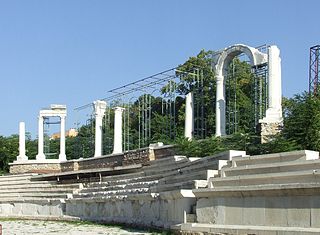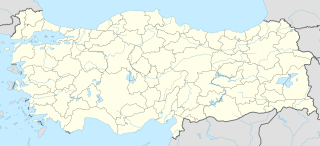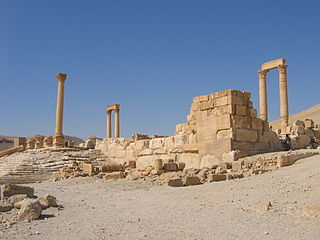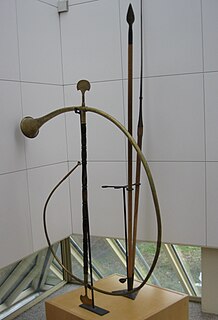 W
WAbusina or Abusena was a Roman castra, and later of town, of the Roman Province of Germania.
 W
WBallistarii were infantrymen of the Roman army who handled ballistae. They were classed as immunes, exempt from fatigue duty of entrenching or building.
 W
WThe Battle of Beroe was a conflict near Stara Zagora, ancient Ulpia Augusta Traiana, between the Romans and Goths in 250 which resulted in a Gothic victory.
 W
WA buccina or bucina, anglicized buccin or bucine, is a brass instrument that was used in the ancient Roman army, similar to the cornu. An aeneator who blew a buccina was called a "buccinator" or "bucinator".
 W
WA castellum in Latin is usually:a small Roman fortlet or tower, a diminutive of castrum, often used as a watchtower or signal station like on Hadrian's Wall. It should be distinguished from a burgus, which was a later Latin term that was used particularly in the Germanic provinces. a distribution, header and settling tank in a Roman aqueduct or it:castellum aquae.
 W
WA cingulum militare was a piece of ancient Roman military equipment in the form of a belt decorated with metal fittings, which was worn as a badge of rank by soldiers and officials. Many examples were made in the Roman province of Pannonia.
 W
WThe comes tractus Argentoratensis was in late antiquity commander of units of the mobile field army of the Western Roman empire, operating along the Rhine frontier in the Diocese of Gaul.
 W
WThe origins of the word domesticus can be traced to the late 3rd century of the Late Roman army. They often held high ranks in various fields, whether it was the servants of a noble house on the civilian side, or a high ranking military position. After serving under the emperor for a certain duration, the Domestici would be able to become leaders themselves and potentially command their own regiment of legionaries in the military. Relatively, the most important offices were the “Comes Domesticorum” also known as, “Commander of the Protectores Domestici,” and “Comes rei Militaris” or General.
 W
WThe draco was a military standard of the Roman cavalry. Carried by the draconarius, the draco was the standard of the cohort, as the eagle was that of the legion.
 W
WFectio, known as Vechten in Old Dutch, was a Roman castellum in the province Germania Inferior established in the year 4 or 5 AD. It was located at the place where the river Vecht (Fectio) branched off from the Rhine, leading to Lake Flevo, which was later to become the Zuiderzee. This was near the modern hamlet of Vechten in the municipality Bunnik, Utrecht, Netherlands.
 W
WLegio XVI Flavia firma was a legion of the Imperial Roman army. The legion was created by Emperor Vespasian in 70 from the remains of the XVI Gallica. The unit still existed in the 4th century, when it guarded the Euphrates border and camped in Sura (Syria). The emblem of the legion was a Pegasus, although earlier studies assumed it to have been a lion.
 W
WThe Ludus Dacicus or The Dacian Gladiatorial Training School was one of the four gladiator training schools (ludi) in Ancient Rome. It was founded by Domitian, completed by Trajan, and was used to train gladiators drawn from among the Dacian prisoners taken by both emperors in their Dacian Wars. It was located east of the Colosseum, on the slopes of the Caelian Hill.
 W
WNavis actuaria was a type of transport ship used by the Roman navy.
 W
WThe praefectus castrorum was, in the Roman army of the early Empire, the third most senior officer of the Roman legion after the legate (legatus) and the senior military tribune, both of whom were from the senatorial class. He was responsible for training, equipment procurement and maintenance, and construction of the camp, but he could command the legion when his seniors were absent. The post was usually held by a soldier promoted from the centurionate, having already served as a chief centurion of a legion, and was therefore open to ordinary citizens. Prefects of this rank, for example Sextus Vibius Gallus, were awarded prizes (dona) to mark their achievements.
 W
WThe Siege of Tyana occurred in 272 CE. The forces of the Roman Emperor Aurelian were seeking to conquer the Palmyrene Empire.
 W
WThe Strata Diocletiana was a fortified road that ran along the eastern desert border, the limes Arabicus, of the Roman Empire. As its name suggests and as it appears on milestones, it was constructed under Emperor Diocletian as part of a wide-ranging fortification drive in the later Roman Empire. The strata was lined with a series of similarly-built rectangular forts situated at one day's march from each other. It began at the southern bank of the river Euphrates and stretched south and west, passing east of Palmyra and Damascus down to northeast Arabia.
 W
WTitus Terrasidius was a Roman Knight of the Equestrian order and an officer of the cavalry in Julius Caesar's Legio VII Claudia. He and other officers of the legion were sent out to negotiate provisions for the winter of 56–55 BC; they were captured by Breton tribes who were then subjugated as Caesar describes in his Commentarii de Bello Gallico:The occasion of that war was this: Publius Crassus, a young man, had taken up his winter-quarters with the seventh legion among the Andes, who border upon the Ocean. He, as there was a scarcity of corn in those parts, sent out some officers of cavalry [who would be equites], and several military tribunes [who would be of senatorial rank] among the neighbouring states, for the purpose of procuring corn and provision; in which number Titus Terrasidius was sent among the Esubii; Marcus Trebius Gallus among the Curiosolitae; Quintus Velanius, [and] Titus Silius, amongst the Veneti.
 W
WIn Ancient Rome the month of March was the traditional start of the campaign season, and the Tubilustrium was a ceremony to make the army fit for war. The ceremony involved sacred trumpets called tubae.